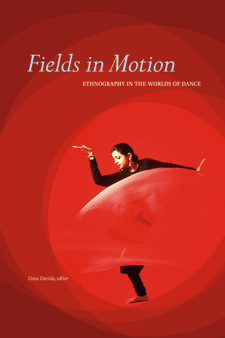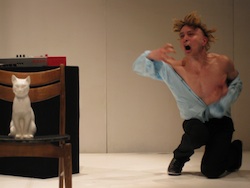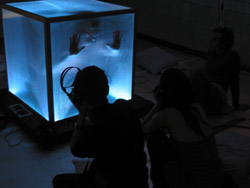A sinking sensation set in as I watched Manon Oligny’s latest work, “Icônes, À VENDRE” (Icons, FOR SALE), part of the Danse-Cité-produced Traces Chorégraphes series. Linking religion and the commodification of women is rich and ripe source material for any production, but words alone do not make a choreographic statement. Unfortunately, the concept versus content debate remained zinging in my head throughout.
Oligny, in this hour-long production by her company, Manon fait de la danse, provides spectators with a kind of catalogue of offerings. The piece, as described in the program, is subdivided into twenty-seven propositions, including Chastity, Benediction, Veneration, Mary Magdalene, the Holy Grace, etc., linked to Roman Catholic religion and symbolism and inferences of prostitution and the sex trade. Prior to the performance, a small glossy pamphlet was handed out to each patron at the entrance, with IKEA-like measurements and details about each of the “items” on sale, including the three characters of the piece, who are called by the first names of the women playing them (Anne Le Beau, Miriah Brennan and Karina Iraola). Essentially, this encourages the spectator to concoct their own kind of show, based on their own selections, but this interactivity never went beyond that first step of catalogue flipping.
The characters detailed in the pamphlet appear on a beautiful bleached wood set created by Yanick Macdonald, incorporating a floor and three arched windows, very much recalling a religious setting. The costumes by Camille Thibault-Bédard, flesh-coloured brassieres and panties, are simple and yet effective in showing the contours of the women’s bodies, each with a price tag dangling from the fabric. An accompanying throbbing industrial score by Guillaume Bourassa and Sébastien Gravel of Création Ex Nihilo is a repetitive, loud wall of sound that plays for the bulk of the piece.
“Icônes” snaps from one stilted section to the next, featuring the three female “icons”: Karina on her knees playing with her “tail” (I alternated between thinking it was a rat tail, or when she dipped it in a bucket of faux-blood, an extended version of a tampon), or sitting, throwing herself forward, legs wide apart; Miriah lunging forward, and then massaging her stomach; and Anne baring her breasts and strutting around the back of the stage. Other Karina sections have the young dancer in several long, slow shakes of her body, seemingly lost in her own world, or throwing one leg back in attitude and then corkscrewing her neck (ouch, is all I could think). Miriah, in another sequence, is in possession mode, with her eyeballs rolled back in their sockets, stationary but spasmodically flailing, then prostrating herself and swinging her hair. Anne could be found sobbing on the floor, which went on for so long that I had plenty of time to think how some good Graham contractions might help her get the emotion across more effectively. Later, seated on a stool, she has the dubious task of massaging her bare breasts, and then jiggling them, leading to a full-body jiggle. I felt sad for Le Beau, who’s the veteran in the group with twenty-five years of dance experience behind her, but things hadn’t exactly improved for the other dancers either: Miriah was hopping on one foot, and later in pointe shoes walked zombie-like across the floor, while poor Karina was doubled over at the other side of the stage.
There’s not much to commend here. The piece isn’t funny, it isn’t ironic and it isn’t even voyeuristic (if that’s your thing). The movement wasn’t metaphor, nor was there any narrative of domination or submission. It was hard to muster any kind of reaction to this litany of boring, lifeless tableaux because the performers were either directed or were unable to project any kind of presence. Nor was there any escapist quotient or wish fulfillment embedded in Oligny’s dance.
Movement vocabulary is not Oligny’s strong point, nor does she seem to comprehend how to build material or advance her theme. “Icônes” is not transgressive or droll, and a pleasure/danger quotient doesn’t seem part of this tepid offering either. Perhaps most depressing and objectionable is how Oligny fundamentally lacks any degree of agency in terms of how she wants to mark (or market) gender and sexual power.
On the other hand, Mélanie Demers, artistic director of the company Mayday, has fire in her belly and she’s created a vital and provocative piece, “Junkyard/Paradise”. Metaphorically, the title evokes the confusing, violent world we live in. Demers knows how to evolve her choreographic ideas, and she chooses not to hit the audience over the head with her concerns. As the scenes evolve, it becomes clear that the piece is more about trying to figure out whatever confusion exists in our everyday lives and relationships, rather than being prescriptive about ‘how to be’ in the world.
This dense production contains some fairly violent entanglements, though not gratuitously so. The dancers – Angie Cheng, Brianna Lombardo, Nicolas Patry, Jacques Poulin-Denis, who’s also the composer, and Demers herself – are a terrific group. They dig into material with ferocity. Particularly strong is the cast’s commitment to whatever task is at hand.
The use of text is another powerful element in “Junkyard/Paradise”. The performers have cultivated a deep understanding of cadence and modulation, and the impact of words. So when a mesmerizing Lombardo moves from cries to whispers, uttering, “I don’t care” repeatedly, you listen, because there is such meaning in the many ways she speaks the phrase, with the silence between words an echo of her torment. Cheng, who is growing as a performer in every production I see her in, also rips into her text, balancing love and hate in fierce sways of emotion. Lombardo prompts Cheng, coaxing her with different line readings, for example, slower, softer. When she finally screams, “You selfish fuck,” registered at Patry in front of her, you shudder at the anger and fear she embodies in every syllable.
Demers paces her scenes, revealing bodies in varying states of vulnerability, whether it is Poulin-Denis playfully slapping and smearing tomato sauce on his body, and then rolling in the stuff; Poulin-Denis aggressively slapping and rubbing muddy glop over Lombardo’s near naked body; or Cheng garishly slashing Patry’s lips with red lipstick. Tutus and playful crowns adorn bodies, almost as distractions during intense sections, like the sequence where Lombardo wraps bright yellow tape (the kind that indicates danger zones) around her bare torso, and then attaches aluminum foil to her hands, or when both Poulin-Denis and Demers find themselves, on separate occasions, wrapped corpse-like in plastic sheeting. In this landscape riddled with tremors and dynamic tensions, enraged bodies fall or slip and come tumbling down.
The socially charged and philosophically tinged title allegorically alludes to Demers’ journey toward reconciling duality – that wading through debris and waste can lead us to the brink of disintegration or our enchantment with life can eclipse its horrors. This paradise is a purgatory, strewn with broken dreams, unstable alliances and unfulfilled potential.
These two evenings of dance, poles apart, reveal two very different abilities; one’s a miss, the other unmissable.
Edited by Kaija Pepper
Tagged: Contemporary, Performance, Montréal , QC






